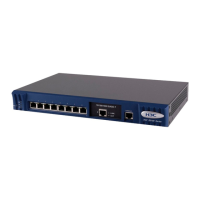1-6
Use the undo attribute command to cancel attribute settings of the user.
You may use display local-user command to view the settings of the attributes.
Examples
# Create local user user1 and set the IP address attribute of user1 to 10.110.50.1, allowing only the user
using the IP address of 10.110.50.1 to use the account user1 for authentication.
<Sysname> system-view
System View: return to User View with Ctrl+Z.
[Sysname] local-user user1
New local user added.
[Sysname-luser- user1] password simple pass1
[Sysname-luser- user1] service-type lan-access
[Sysname-luser-user1] attribute ip 10.110.50.1
authentication
Syntax
authentication { radius-scheme radius-scheme-name [ local ] | hwtacacs-scheme
hwtacacs-scheme-name [ local ] | local | none }
undo authentication
View
ISP domain view
Parameters
radius-scheme radius-scheme-name: Specifies to use a RADIUS authentication scheme. Here,
radius-scheme-name is a string of up to 32 characters.
hwtacacs-scheme hwtacacs-scheme-name: Specifies to use an HWTACACS authentication scheme.
Here, hwtacacs-scheme-name is a string of up to 32 characters.
local: Specifies to use local authentication scheme.
none: Specifies not to perform authentication.
Description
Use the authentication command to configure an authentication scheme for current ISP domain.
Use the undo authentication command to restore the default authentication scheme setting of current
ISP domain.
By default, no separate authentication scheme is configured for an ISP domain.
Note that:
z Before you can use the authentication command to reference a RADIUS scheme in current ISP
domain, the RADIUS scheme must already exist.
z If you execute the authentication radius-scheme radius-scheme-name local command, the local
scheme is used as the secondary authentication scheme in case no RADIUS server is available.
That is, if the communication between the switch and a RADIUS server is normal, no local
authentication will be performed; otherwise, local authentication will be performed.

